Greenhouse gases –> global warming –> climate change
Country by country temperature anomalies from 1900 to the present day as a neat chart, an international problem
Animation by Antti Lipponen, a physicist at the Finnish Meteorological Institute.
36.2055 years in science communication
Don’t often see avian couples together…or more to the point, I don’t often catch them “on film” together. Here are Mr and Mrs Linnet (Linaria cannabina) at their residence in Rampton Pocket Park a few miles north of Cambridge. The bird’s English name comes from the species’ fondness for flax seed from which we make linen, the second part of its scientific name from its liking for hemp seed (Cannabis sativa). The bird is found across Europe into western and central Siberia and is non-breeding in north Africa and southwest Asia.
As you can hopefully see from my not particularly sharp photo the species is sexually dimorphic (the male and female are different): the male in summer has a red breast, grey nape, and red head-patch, while the females and juveniles lack the red colouring and have white underparts, with a buff-speckled breast.
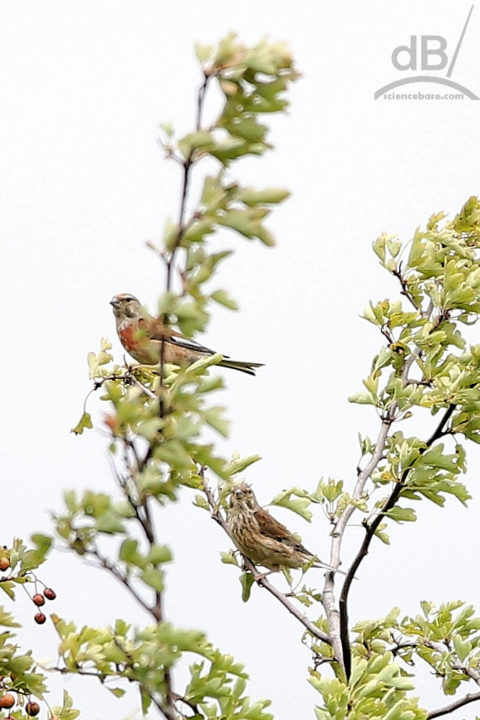
Originally, the linnet was placed in the genus Carduelis, putting it squarely in with a finch grouping within the Fringillidae. Indeed, the linnet rather resembles the chaffinch and its high-pitched call (not always a “linnet-linnet-linnet”) resembles the jangling coins sound of the goldfinch. However, DNA evidence suggests that the linnet is not of the same genetics as the Carduelis finches and that it is on its own branch of the taxonomic tree of life. Hence, it is now in its own genus, Linaria, meaning linen weaver from the Latin.
There are several sub-species of Linaria cannabina in different parts of the world:
L. c. autochthona – Scotland
L. c. bella – Middle East to Mongolia and northwestern China
L. c. mediterranea – Iberian Peninsula, Italy, Greece, northwest Africa and Mediterranean islands
L. c. guentheri – Madeira
L. c. meadewaldoi – western Canary Islands (El Hierro and Gran Canaria)
L. c. harterti – eastern Canary Islands (Alegranza, Lanzarote and Fuerteventura)
Regular readers will know the Classic Chords series I started a year or two ago as a musical aside. It continues to attract attention and there are now more than 20 in the collection everything from The Beatles and The Rolling Stones to Rush and Foo Fighters. You can find the first Classic Chord here and work your way onwards and upwards.
I’ve been on photo site/community 500px for years but only this year, with my focus on birds have I really got into the community. There are some stunning photos on there. And, it’s very gratifying to have one’s own photos seen and “liked”, of course. Here’s a contact sheet of my most popular snaps, all of which have had above a 95/100 pulse and a goodly proportion of likes from those that view them. In the array top row to bottom, left to right:
Sedge warbler | Female great crested grebe
Pectoral sandpiper | Avocets | Teasels | Common Kingfisher
Grey heron | Juvenile greylag goose | Female moorhen | Green woodpecker
Obviously, not all the photos I post on 500px are of birds, the vast majority are, but many of the insects, plants, landscapes and others do quite well, and in this case, the blooming teasels outstrip many of the avians. In my galleries at the time of writing: 92 bird photos, 43 general nature, 29 architecture, 18 flowers, 13 Misc.
The new artwork for my song “Turncoats” was a stylised photo of three people walking with their backs to the sea. The photo was nice enough, but messing around with the Prisma app gave me some even more stylised versions of the original, contact sheet below.

This is perhaps my favourite Prisma version of my original snap

Swifts, swallows, and housemartins (Delichon urbica) never seem to stop their flight once they arrive at our shores in the spring. Today, there was a whole flock of housemartins gathering on overhead wires in Aldreth, Cambridgeshire, to preen and perhaps make their plans for the long and perillous return journey to sub-Saharan Africa. Their summer of breeding and feeding in the British Isles and the European mainland nearing an end.
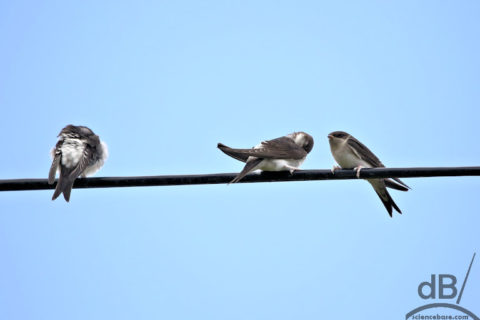
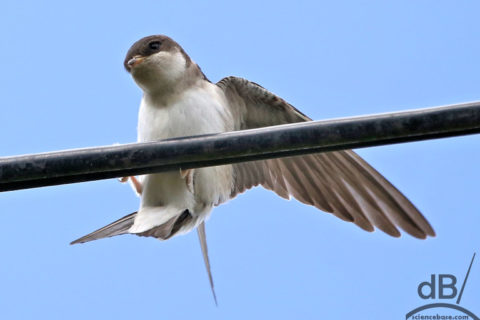
Often the way, you’re looking for one bird, when you hear and then spot another. Happens a lot with the yellowhammer (Emberiza citrinella). Today, I was walking a short distance along the Aldreth Causeway and could hear avian jostling over the floodbank, scrambled to the top, saw nothing but flittering wings heading into the scrub, turned around and encountered this yella fella, sitting among the seed heads, not twenty feet from where I stood, making his call…
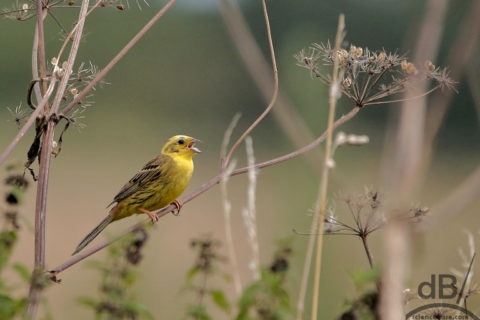
It’s distinctive call, Mrs Sciencebase’s Dad always told her, sounds like the bird was passing out the post-war rations: “two-slices-of-bread-but-no-cheeeeese” (Story No. 237). But, Richard Smyth, my E&T stablemate, also shows his age in his book A Sweet Wild Note by suggesting it’s more of a “chika-chika-chika-chikaaaah”. It sounds very similar to the pine bunting with which it interbreeds and like a different avian dialect version of the reed bunting’s call. Either way the yellowhammer is a lemon-coloured bunting and definitely not a canary as one fellow dogwalker insisted!
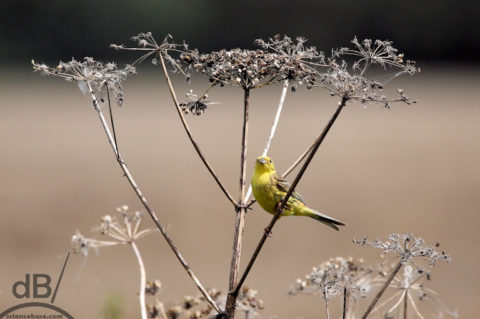
The hammer part of its name comes from the German word for bunting, ammer, first recorded in 1553 as yelambre. Oddly enough the “Emberiza” part of its scientific binomial (the name a lot of people refer to as an organism’s “Latin name”) also comes from the Old German embritz, meaning bunting. Citrinella is an Italian word for a small yellow bird.
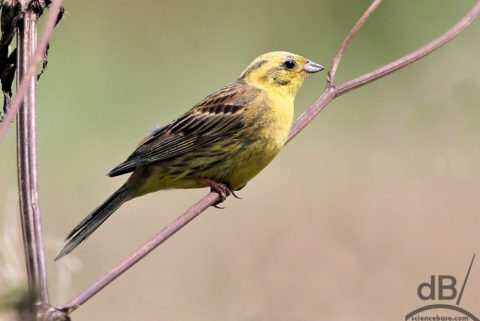
I got reasonably close to this male yellowhammer and perhaps captured the best few shots of this species I have taken to add to my bird gallery.
Graduation ceremonies are rarely exciting affairs…except for family members watching their beloved chill roll up in a mortarboard and cape to grab their scroll. But, watch one student, Alexander Godfrey, at his graduation ceremony as he exits stage right…you won’t believe what he does after the ceremonial handshake with the dignitaries…

Mum, Wendy Godfrey, was more than a little bemused whilst videoing her son’s graduation on her phone. “I didn’t know he was going to do it,” she laughs. “As he was about to leave the stage he raised his mortarboard and I thought he was going to throw it in the air, like they do, but then he did this victory roll across the stage, almost everyone in the auditorium, was laughing!”
She adds that, “Nothing my boy does surprises me, I blame the acting lessons we spent a fortune on over the years. Give him a stage and he’ll take a mile. He’s always the centre of attention because of his antics, he’s got an album coming out soon, you know?”
Speaking of which Alex confirmed to Sciencebase that his album based on his Acid Tea music project will indeed be out at the end of 24th August. “It’s an ultra-colourful, poem-filled CD album of my psychedelic electronic jazzy/bluesy/rock experiments…” Alex enthuses.
Apparently, magpies (Pica pica) are invoked in Christian allegory because they look like a composite of a white dove and a black raven…they were alleged to have perched on the prow of The Ark during the Biblical flood and to have cackled and laughed whilst the world drowned…

Then there’s the nursery rhyme, made famous for British children of the 1970s by the ITV rival to Blue Peter, Magpie. The theme tune for the show perhaps usurped earlier, traditional versions of the nursery rhyme from our collective psyche.
One for sorrow, Two for joy, Three for a girl, Four for a boy, Five for silver, Six for gold, Seven for a secret, Never to be told. Eight for a wish, Nine for a kiss, Ten for a bird, You must not miss.
There are versions that begin:
One for sorrow, Two for mirth, Three for a funeral And four for birth
and
One for sorrow, Two for mirth Three for a funeral, Four for birth Five for heaven Six for hell Seven for the devil, his own self
Why the magpie gets such a raw deal in mythology and folkore is perhaps down to the sound it makes, the cackling laughter, and perhaps also because it ties together white and black, day and night, good and bad, light and shade…either way it’s just a bird, a corvid, or crow, albeit a clever one.
Listen:
A pair of hobbies (Falco subbuteo) took up residence in an abandoned rook’s nest at “The Lodge” RSPB reserve some time ago. They hatched three chicks which are thriving and providing hours of entertainment for birdwatchers and staff at the reserve.
It’s probably another week before they fledge. Their diet seems to consist of mainly dragonflies from the moorish land around their lonesome pine although one photographer (Colin Severs) I met had footage of an adult tearing apart a swallow (Hirundo rustica) on a branch near the nest to make bite-sized nuggets for the offspring.
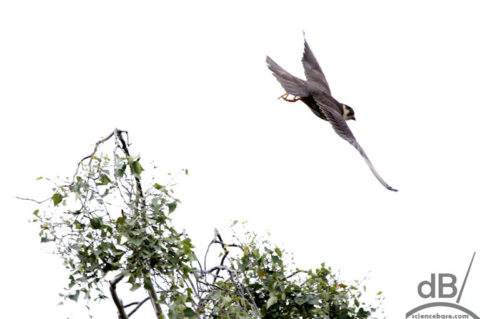
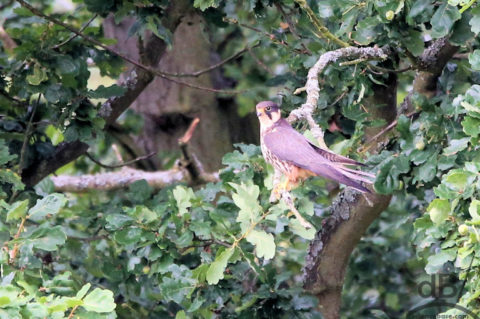
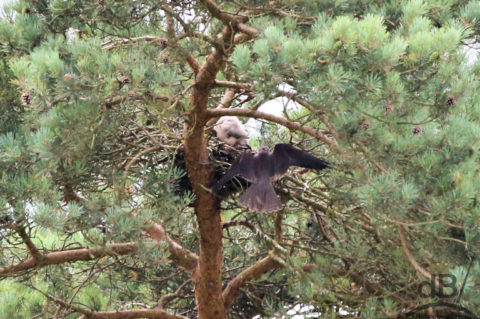
These birds are spectacular enough to have made it worth the trip to the reserve but there were also several buzzards (Buteo buteo) around including at least one juvenile, green woodpeckers (Picus viridis), common whitethroats (Sylvia communis), the family of bullfinches (Pyrrhula pyrrhula) purportedly also nesting near the hobbies remained elusive.
Also remaining hidden were the nuthatches (Sitta europaea) and treecreepers (Certhia familiaris). Apparently, a pied flycatcher (Ficedula hypoleuca) that had been showing well was predated last, perhaps by a jay (Garrulus glandarius). I’ve only ever seen one of these birds, dead on a footpath, many years years ago. Attending the birdfeeders around the site were blackcaps (Sylvia atricapilla), dunnocks (Prunella modularis), chaffinches (Fringilla coelebs), blue tits (Cyanistes caeruleus) with young and great tits (Parus major), and a solitary robin (Erithacus rubecula) and a lone magpie (Pica pica).